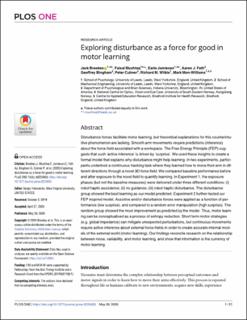| dc.contributor.author | Brookes, Jack | |
| dc.contributor.author | Mushtaq, Faisal | |
| dc.contributor.author | Jamieson, Earle S. | |
| dc.contributor.author | Fath, Aaron J. | |
| dc.contributor.author | Bingham, Geoffrey Parker | |
| dc.contributor.author | Culmer, Peter R. | |
| dc.contributor.author | Wilkie, Richard M. | |
| dc.contributor.author | Mon-Williams, Mark | |
| dc.date.accessioned | 2021-03-25T10:39:32Z | |
| dc.date.available | 2021-03-25T10:39:32Z | |
| dc.date.created | 2021-02-24T14:54:51Z | |
| dc.date.issued | 2020 | |
| dc.identifier.citation | Brookes, J., Mushtaq, F., Jamieson, E., Fath, A. J., Bingham, G., Culmer, P., Wilkie, R. M. & Mon-Williams, M. (2020). Exploring disturbance as a force for good in motor learning. PLoS One, 15(5), e0224055. | en_US |
| dc.identifier.issn | 1932-6203 | |
| dc.identifier.uri | https://hdl.handle.net/11250/2735484 | |
| dc.description.abstract | Disturbance forces facilitate motor learning, but theoretical explanations for this counterintuitive phenomenon are lacking. Smooth arm movements require predictions (inference) about the force-field associated with a workspace. The Free Energy Principle (FEP) suggests that such 'active inference' is driven by 'surprise'. We used these insights to create a formal model that explains why disturbance might help learning. In two experiments, participants undertook a continuous tracking task where they learned how to move their arm in different directions through a novel 3D force field. We compared baseline performance before and after exposure to the novel field to quantify learning. In Experiment 1, the exposure phases (but not the baseline measures) were delivered under three different conditions: (i) robot haptic assistance; (ii) no guidance; (iii) robot haptic disturbance. The disturbance group showed the best learning as our model predicted. Experiment 2 further tested our FEP inspired model. Assistive and/or disturbance forces were applied as a function of performance (low surprise), and compared to a random error manipulation (high surprise). The random group showed the most improvement as predicted by the model. Thus, motor learning can be conceptualised as a process of entropy reduction. Short term motor strategies (e.g. global impedance) can mitigate unexpected perturbations, but continuous movements require active inference about external force-fields in order to create accurate internal models of the external world (motor learning). Our findings reconcile research on the relationship between noise, variability, and motor learning, and show that information is the currency of motor learning. | en_US |
| dc.language.iso | eng | en_US |
| dc.rights | Navngivelse 4.0 Internasjonal | * |
| dc.rights.uri | http://creativecommons.org/licenses/by/4.0/deed.no | * |
| dc.title | Exploring disturbance as a force for good in motor learning | en_US |
| dc.type | Peer reviewed | en_US |
| dc.type | Journal article | en_US |
| dc.description.version | publishedVersion | en_US |
| dc.rights.holder | © 2020 Brookes et al. | en_US |
| dc.source.volume | 15 | en_US |
| dc.source.journal | PLOS ONE | en_US |
| dc.source.issue | 5 | en_US |
| dc.identifier.doi | https://doi.org/10.1371/journal.pone.0224055 | |
| dc.identifier.cristin | 1893272 | |
| dc.source.articlenumber | e0224055 | en_US |
| cristin.ispublished | true | |
| cristin.fulltext | original | |
| cristin.qualitycode | 1 | |

